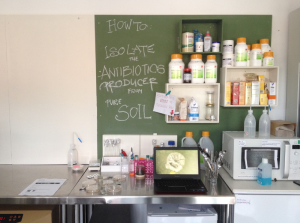
Lecturer: Mindaugas Gapševičius
Credits: 6 ECTS, 4 SWS
Date: Wednesdays 17:00-20:30
Venue: Marienstraße 7b, Biolab (Room 202)
First meeting: Wednesday, 16 October 2019; 17:00-20:30
Raised beds in gardening allow to easier control soil nutrients, levels of water and their inhabitants. In our aquariums, we tend to find a balance between ph levels of water, algae and pets. How to systemically approach a sample of soil and to find alternative uses of it?
In the forthcoming course, we will focus on Caenorhabditis elegans, a transparent nematode, of about 1 mm in length. The goal of the course is to systemically approach the organism and to develop an artistic project in conjunction with its habitats. What habitat does it need? What is a function of the nematode in a soil? How to organize my soil? While trying to answer the questions, we will learn how to read scientific papers, how to prepare medium for the organism, how to understand who lives next to it, and how to control the habitat of it. The know-how will pave a ground for our artistic ideas.
The course extends the project module Soil–Humus–Earth and is conceptualized for a work in the DIY biolab of the Media Environments chair. Part of the course is a block module implemented together with the microbiologist Dr. Julian Chollet, who will contribute to the course with scientific know-how.
During the semester we will develop individual projects, document and present them on the GMU Wiki.
Syllabus
- 16.10.2019 /Introduction
Documentation
Students
References
Toland, A., Noller, J. S., Wessolek, G. (2018). Field to Palette: Dialogues on Soil and Art in the Anthropocene, Boca Raton: CRC Press / Taylor and Francis. ISBN 1138297453
C. elegans
- File:intro-feeding-celegans-teach-student-3-4.pdf
- File:C. elegans A Model Teaching Organism Carolina.pdf
- File:Introduction to Feeding Preferences in Caenorhabditis elegans Carolina.pdf
- File:Living Organism Care Guide Caenorhabditis elegans Carolina.pdf
- File:nematodeisolation.pdf
- File:strainmaintain.pdf